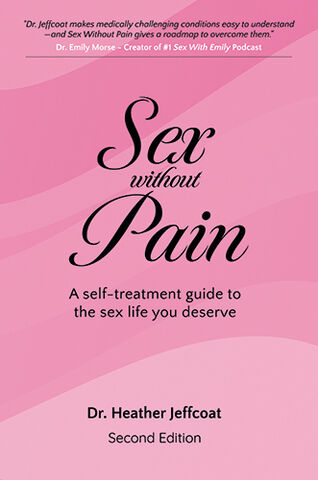Heather Jeffcoat, DPT
The Many Benefits of Pelvic Floor Physical Therapy Are Still Being Discovered
Despite its increased recognition as valuable therapy for many symptoms, there is still a lot to be learned
Natalie begins with some thoughts on what she was expecting from her session and how wrong she was about her preconcieved notions. She expected something akin to a Pilates class, perhaps in part because she had seen so much info on Pilates and yoga on our site. She may have been surprised to discover that Pilates and yoga are only one aspect of what we offer:
In 2021, Well+Good called it: People would be paying closer attention to the pelvic floor muscles. This prediction is holding up, says Heather Jeffcoat, DPT, a pelvic floor physical therapist and owner of Femina Physical Therapy, who has noticed a higher demand than ever for pelvic floor physical therapy. To see what all the buzz is about, I decided to try pelvic floor physical therapy with Dr. Jeffcoat. I expected it would be like a Pilates class (I even dressed for it), but I quickly realized that this would be more like a physical check-up.
At our practice we often utilize a multi-disciplinary approach, because we know how interconnected the body's systems are and how they can affect a person's whole body health. When was the last time you attended a Pilates class and received a physical checkup beforehand? This is just one example of how we achieve the results we do!
Natalie continues:
Before I get into my experience, let's start with a little background: Pelvic floor physical therapy rehabilitates the muscles in a person’s pelvic floor, which run from the pubic bone to the tailbone. These muscles are important because, among other things, they play a role in supporting the pelvic organs, controlling the bladder and bowels, and allowing for healthy sexual function. Research suggests that pelvic floor physical therapy helps with symptoms and conditions including (but not limited to):
- Urinary issues, like incontinence, urgency and frequency, and painful bladder syndrome
- Bowel problems, like chronic constipation and fecal incontinence
- Sexual and vulvar dysfunction, like pain during intercourse or tampon insertion
And she's right! To think that a single prong approach to such a complex set of issues is just too limited a way of looking at it. Many of our clients have discovered this for themselves, and the benefits of pelvic floor physical therapy speak volumes!
So now it was on to the questionnaire that we ask every patient to fill out beforehand. It goes more in depth into the three bullet points outlined above.
Here's what trying pelvic floor physical therapy was like
I filled out eight pages of paperwork before I saw Dr. Jeffcoat, including a “Pelvic Floor Impact Questionnaire,” designed to determine how pelvic floor pain might impede my ability to live life normally. The impact questionnaire is broken down into three categories—bladder or urine, bowel or rectum, and vagina or pelvis. Why? Dr. Jeffcoat says your pelvic floor therapist should take a three-pronged approach that includes the bladder, the bowels, and the vulva or sexual organs because the pelvic floor impacts each of these.
Right off the bat this is where the public perception of what we do can start to change. Patients often come to realize that an overly simplistic view of pelvic floor health is just not going to get to the root of many pelvic floor problems.
...most people (and medical forms) might use "sexual health" and "vaginal and vulvar health" interchangeably; however, pelvic floor issues extend beyond painful sex...
Enough of the questions, it's time for some answers
Moving on from the questionnaire, Natalie goes into more detail about the actual exam process. Her surprise at the attention given to all areas of the pelvic floor exam, both external and internal, is not new to us. So many people come to us with only a superficial knowledge of the complexity of pelvic floor issues, only to leave with a new understanding of how interconnected these issues can be, and what can be done to address them!
For example:
Dr. Jeffcoat says she would clearly communicate what she's doing and how it's beneficial for anyone caught off guard by the internal exam. If someone is having a tough time with the vaginal wall examination, which Dr. Jeffcoat says is not an infrequent occurrence, she might reschedule the internal exam.
All that said, Dr. Jeffcoat walked me through the entire process, letting me know before she inserted her finger into my vagina, and she also explained what she was doing throughout the exam. This helped make everything a little less awkward.
Ultimately, Dr. Jeffcoat noticed that I had a bit of pain as she examined the deepest vaginal wall. She prescribed an exercise to help with that discomfort, and she gave me a form detailing how to perform that exercise at home. I felt more empowered to take care of my physical health because I had an easy-to-follow step-by-step guide.
Remember when Natalie said "I wasn't expecting Dr. Jeffcoat to "find" anything during my visit"? This proves that even minor but hidden issues can often be found - and corrected - to the benefit of overall health and wellbeing. And she gets it when I say:
Regardless of in-office frequency, all patients should be given a home program to reinforce the techniques learned in their sessions, Coming to physical therapy once a week, without any follow-through at home, may not give the patient the results they desire."
After going through the whole exam from start to finish Natalie sums up her experience, and she offers some advice to those seeking the benefits of pelvic floor physical therapy as a way to better pelvic floor health:
A few tips for your first pelvic floor physical therapy session
Some folks might be uncomfortable or experience pain with the internal part of the exam, says Dr. Jeffcoat. “One way to reduce this is to make sure your provider is communicating with you throughout—that they tell you when they will be moving from one spot to the next, and what they are going to be assessing at each spot,” she says. “Clear communication is the best way to proceed with ... any type of physical exam.”
Pelvic floor physical therapy may not have been what I was expecting, but it can help folks who experience some pain and other symptoms.
I would like to personally thank Natalie for her patience and dedication in not only writing such a fair and comprehensive article, but also in going through the whole exam process from start to finish. I think she may agree and it would be fair to say that she has a much more enlightened view of the benefits of pelvic floor physical therapy as a whole, and how our therapies can help a variety of conditions.
Use our simple contact form to begin your journey toward reaping the benefits of pelvic floor physical therapy for yourself. We look forward to hearing from you!













